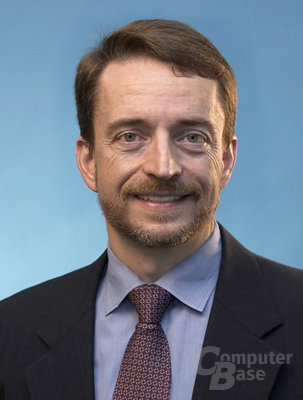Pat Gelsinger verlässt Intel
Wenige Tage vor dem Intel Developer Forum (IDF), das ab dem 22. September stattfinden wird, berichten mehrere Medien, dass der 48-jährige Pat Gelsinger, Technologie- und Forschungs-Chef bei Intel, das Unternehmen nach rund dreißig Jahren verlassen wird.
Sein Weg soll ihn dabei zum Speicher-Spezialisten EMC führen, wie die New York Times in ihrer heutigen Ausgabe berichtet. Laut Wall Street Journal wird er dort das Speichergeschäft und mehrere kleine Software-Bereiche leiten. Er steigt bei EMC somit neben Howard Elias, Manager bei EMC, und David Goulden, Finanzchef bei EMC, direkt als potentieller Nachfolger von Joseph Tucci, EMC-Chef, ein, der die Geschäfte zunächst jedoch selbst weiter leiten werde.

Laut New York Times plane Intel einen Umbau des Managements, bei dem Sean Maloney zukünftig Verantwortung für das gesamte Prozessorengeschäft übernehmen werde. Bisher war er Marketing- und Verkaufschef bei Intel. Sean Maloney gilt derzeit als Kandidat für die Nachfolge von Intel-CEO Paul Otellini.
Gelsinger hatte das IDF 1997 ins Leben gerufen. Auf der diesjährigen Veranstaltung soll er nach bisherigen Informationen eine Keynote halten. Pat Gelsinger kam 1979 zu Intel, leitete daraufhin Fabriken und wurde erster Chief Technology Officer (CTO) von Intel überhaupt. Vorher hatte er diesen Titel bereits bei der Intel Architecture Group inne, die die nächsten Generationen von Hard- und Software für alle Intel-Plattformen entwickelt. Zuvor leitete er die Desktop Products Group und zeichnete für die Desktop-Prozessoren, -Chipsätze und -Mainboards verantwortlich. Von 1992 bis 1996 beschäftigte er sich mit der „Intel ProShare Video Conferencing and Internet Communications“-Produktlinie von Intel. Zuvor war er als Manager in der für die Pentium Pro, IntelDX2 und Intel486 Prozessoren verantwortlichen Abteilung tätig. Darüber hinaus war er bereits in den Entwicklerteams des i386 und i286 beschäftigt. Mit 32 wurde er zum jüngsten Vice President in der Geschichte des Unternehmens.
Intel hat die Berichte des Vormittags bestätigt. Demnach wird das Management umstrukturiert und Pat Gelsinger und Bruce Sewell verlassen das Unternehmen. Sewell war unter anderem für die Corporate Social Responsibility (CSR) von Intel verantwortlich.
Anbei die Presseerklärung von Intel:
SANTA CLARA, Calif., September 14, 2009 – Intel announced a number of important organizational changes today and expansion of some key executive responsibilities.
The changes align the business around the core competencies of Intel Architecture and world class manufacturing, placing operating responsibility for them in three senior executives. In making the changes, Paul Otellini, Intel's chief executive, will devote a higher quotient of his time to corporate strategy and driving the company's growth initiatives.
First, Intel is consolidating all of its major product divisions into the newly formed Intel Architecture Group (IAG), which will be co-managed by Sean Maloney and Dadi Perlmutter, both executive vice presidents. Maloney will be responsible for business and operations while Perlmutter will lead product development and architecture. Reporting to them will be all of Intel's components businesses based on the Intel architecture, as well as all the development and marketing teams needed to bring these products to market.
Second, Intel's global manufacturing organization, the Technology and Manufacturing Group (TMG), will now report to Andy Bryant, Intel's chief administrative officer and also an executive vice president. The move formalizes the role of influence Bryant already plays with TMG and further increases Otellini's time on business strategy. The TMG organization under Bob Baker, Bill Holt and Brian Krzanich will report to Bryant but otherwise remain unchanged. Baker will continue to oversee Intel's NAND flash memory business.
In addition to micro-architecture planning, microprocessor and chipset development, SOC (system on a chip solutions) and wireless teams managed by Steve Pawlowski, Sunil Shenoy, Rony Friedman, Rob Crooke and Raviv Melamed respectively, there will be six business groups operating under the new IAG umbrella. The first is the PC Client Group that will consolidate Intel's existing mobile and desktop product operations. As markets shift to a higher mix of mobile products, this new group will take advantage of common building blocks that have existed for years and enable Intel to better scale cross-platform efforts like security and manageability. The PC Client Group will be led by Mooly Eden. The second is the Data Center Group, focused on servers, cloud computing, networking and high-performance computing. This group will be led by Kirk Skaugen. The third is the Visual Computing Group, focused on advanced visualization products, and led by Jim Johnson. The fourth is the Ultra Mobility Group, which will continue to be led by Anand Chandrasekher and will focus on extending the Intel architecture into mobile handheld devices. The fifth is the Embedded and Communications Group, which Doug Davis will continue to lead. And the sixth is the Digital Home Group, still under Eric Kim, that is driving Intel chips into a variety of entertainment systems and consumer electronic applications.
In addition, with Maloney's move to IAG, Tom Kilroy will assume responsibility for Intel's Sales and Marketing Group (SMG). Kilroy was previously co-manager of processors for enterprise-class applications, the unit previously known as the Digital Enterprise Group (DEG). Kilroy will report to CEO Otellini.
Separately, Intel also announced today that Pat Gelsinger and Bruce Sewell have decided to leave the company to pursue other opportunities. Gelsinger co-managed DEG and Sewell served as Intel's general counsel. Suzan Miller, currently deputy general counsel, will take the role of interim general counsel. "We thank Pat and Bruce for many years of service to Intel and wish them well in their future endeavors," said Otellini.
